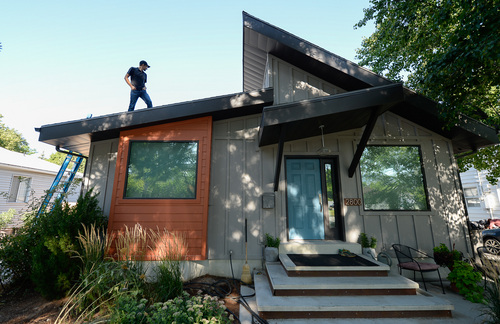This is an archived article that was published on sltrib.com in 2014, and information in the article may be outdated. It is provided only for personal research purposes and may not be reprinted.
As winter heads toward spring every year, the electrical output from the solar array atop David Bennett's Park City home climbs while his power usage declines with the lengthening days.
As a result, Bennett "banks" hundreds of kilowatt hours with Rocky Mountain Power to cover his power needs when the sunshine isn't pouring into his photovoltaic panels.
But on March 31, the end of the annual billing cycle, the utility zeroes out such "net metered" accounts, meaning these customers often forfeit a significant slice of their excess power. Bennett and other Utah solar-powered homeowners point to this annual gift to RMP to argue against its controversial proposal to impose a monthly $4.65 "facilities charge" on net-metered customers.
"This is such a blatant attempt to discourage future solar. It's scandalous," Bennett said.
But the utility says the expired credits are not much of a gift because the power Bennett and others produce on their roofs is of little use to the utility.
Less than .5 percent of RMP's residential customers, currently about 2,700, have net meters — which measure both the power they pull off the grid and the excess solar power they put back in — but the number is rapidly growing as the popularity of rooftop arrays grows.
With backing from state officials, RMP says the proposed fee would ensure such customers help cover the utility grid's massive costs that remain fixed regardless of how much power it moves. They avoid covering their share of maintaining this infrastructure by lowering their monthly bills, the utility argues. The Utah Public Service Commission (PSC) is expected to decide whether to approve the fee by early next month.
Clean-energy advocates have called on the commission to reject the fee, while local governments and political leaders have asked the three-member panel to postpone a decision until it conducts a meaningful cost-benefit analysis of net metering.
Salt Lake City Mayor Ralph Becker and other leaders contend the fees' proponents ignore the broad benefits solar power provides society and the environment by reducing the state's reliance on coal.
The utility, which claims such benefits are illusory, has framed the issue as one of "social justice," saying customers who cannot afford to net meter should not subsidize those who equip their homes with solar. Last year, net-metered customers put nearly 1 million kilowatt hours (kWh) into the grid. That's not much, equivalent to what about 100 Utah homes use in a year, said utility spokesman Dave Eskelsen.
RMP values that power at about 3 cents per kWh, far less than the 8.8 to 14 cents it charges. A kilowatt hour is the amount of electricity needed to power 10 100-watt light bulbs for an hour.
Power that is valuable to the utility is available in bulk and can be accessed when needed, especially when demand peaks between 4 p.m. and 7 p.m., Eskelsen said. These are the very qualities that the power from solar arrays lacks.
But clean-energy advocates say RMP sells excess net-metered power, typically generated during the middle of summer days, to these customers' neighbors at retail rates. This is power it does not have to generate at centralized coal-burning stations and ship more than 100 miles through the grid, losing much of it along the way, said Jared Campbell, a net-metered customer in Salt Lake City.
"Even if there is a surge in demand at 5 p.m., there is still huge demand at noon they have to supply," said Campbell, who generates more power than he can use. On sunny June days his home can pump around 40 kilowatts into the grid between 11 a.m. and 3 p.m.
He had more than 1,100 kWh left in his account on March 31 when it was reset to zero. This represents electricity that was used by his neighbors who paid RMP about $100 for it.
Bennett forfeited 1,150 kWh on March 31 and 1,849 the year before. Campbell's and Bennett's big surpluses reflect their large systems, both exceeding seven kilowatts. A more typical surplus is the 500 to 600 kWh forfeited each year by Ted and Paulette Roche, of Sandy.
But according to RMP data, those who lose credits are a minority, representing about one-sixth of all net-metered customers. This year a total of 264,176 kWh expired. The utility valued these credits at $10,620 and will use this money next year to reduce bills for low-income ratepayers.
"We advise to size your system to match your home's need," Eskelsen said.
In Campbell's case, he increased his home's needs — by converting all his heating needs to electricity and driving an electric Nissan Leaf — to match his 40-panel system.
The Roches' 7.7-kilowatt system covers nearly all the power needs for their Sandy home, equipped with air conditioning and a hot tub. Martha Kay powers her Vernal home with a 4.6-kilovolt system. These customers believe the utility is grossly undervaluing the power they supply.
"RMP doesn't incur the expense of producing our power .... yet sells it at its going rate, therefore making a profit on my power and those of other solar panel customers," Kay wrote in an email.
But Eskelsen contends this electricity is not worth nearly as much as net-metered customers think, in part because the grid is designed for one-way flow of electrons. That limits how far the solar power they generate can be sent.
"They are talking about energy and we are talking about fixed costs," Eskelsen said, arguing net-metered customers receive a substantial benefit by being hooked into a grid they are not fully funding.
"They are virtually storing energy in the utility system and taking it in the following months when their system is not producing," Eskelsen.
"The rate at which they are being credited for the power they produce is three or four times its value to the utility. I understand emotions are running high, but belief is not evidence. They made an assumption about net meter installation that is unwarranted."
The utility argues that net metering benefits no one other than the solar-power customers who minimize their power bills. Rooftop photovoltaics do not offset the need to generate power at centralized plants or lessen pressure on the grid, RMP experts testified last week before the PSC.
However, the record reflects little effort to explore the potential benefits of net metering, according to retired regulator Judith Johnson, whose 13-year tenure with the Utah Division of Public Utilities spanned the wild price spikes of 2000-01. She argued rooftop solar can act as an invaluable hedge against fluctuations in the wholesale prices of power and fuels.
Price regulation is imprecise and based on averages, Johnson noted. Accordingly, no one expects rural customers to pay more for power, though servicing them requires greater infrastructure investments.
The same argument RMP is using to charge solar-equipped homes extra could be used against rural residents, as well as those who use less power either through efficiency measures or because they are too poor to own air conditioners and electronics, she told the commission Tuesday, when the panel heard six hours of public comments.
How the $4.65 charge for solar customers was calculated
Rocky Mountain Power determined the average monthly usage for residential customers is 698 kilowatt hours, which results in a $16.72 contribution toward RMP's fixed costs. Net-metered customers' average use is 518 kWh, so their contribution is $12.46.
The difference is $4.26, the amount the utility first proposed as a "facilities charge" on net-metered customers. It has since increased that to $4.65 after it agreed to raise the monthly service charge from $5 to $6 instead of to $8. —
Net metering, by the numbers
2,412 • Net-metered Utah customers (as of March 31)
686 • New facilities installed in 2013
17.8 megawatts • Generation capacity
975,019 kilowatt hours • Excess generation
264,176 kilowatt hours • Lost by net-metered customers when credits expired
Source Utah Public Service Commission

















